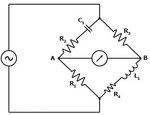SK245230
Member level 3

I am trying to measure capacitors and inductors using the bridge method. (There might be other ways to do this but I want to understand this method)

There is one thing that I don't understand. We measure an inductor L1 and it's serial résistor R4 by tuning a capacitor C1 and a resistor R2, but the capacitor has also it's own ESR. So how is it possible to measure R4 without knowing R2 because of the ESR?:bang:
Moreover R4 should be somewhere near 0.1ohm or 1ohm, so how do I tune such a small résistor?

There is one thing that I don't understand. We measure an inductor L1 and it's serial résistor R4 by tuning a capacitor C1 and a resistor R2, but the capacitor has also it's own ESR. So how is it possible to measure R4 without knowing R2 because of the ESR?:bang:
Moreover R4 should be somewhere near 0.1ohm or 1ohm, so how do I tune such a small résistor?

